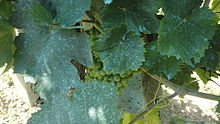- Bordeaux mixture
-
Bordeaux mixture is a mixture of copper(II) sulfate and slaked lime used as a fungicide in vineyards. It is used mainly to control garden, vineyard, nursery and farm infestations of fungi, primarily downy mildew which can result from infections of Plasmopara viticola. It was invented in the Bordeaux region of France, where it is known locally as Bouillie Bordelaise. This fungicide has been used for over a century and is still used, although the copper can leach out and pollute streams.
Contents
Main uses
As well as its use to control fungal infection on grape vines the mixture is also widely used to control potato blight, peach leaf curl and apple scab.[1] It is approved for organic use and so is often used by organic gardeners where non-organic gardeners would prefer other controls.
History
In the 19th century there were several outbreaks of vine diseases among the Vitis vinifera vines of the classicial European wine regions. These outbreaks were caused by pests to which these vines lacked resistance, carried on vines brought to Europe as botanical specimens of American origin. These pests included not only the Great French Wine Blight caused by the aphid Phylloxera vastatrix, but also mildew and other diseases caused by fungi.[2]
After the downy mildew had struck, botany professor Pierre-Marie-Alexis Millardet of the University of Bordeaux was studying the disease in vineyards of the Bordeaux region. Millardet then noted that vines closest to the roads did not show mildew, while all other vines were affected. After inquiries, he found out that those vines had been sprayed with a mixture of copper sulfate and lime to deter passersby from eating the grapes, since this treatment was both visible and bitter-tasting. This led Millardet to conduct trials with this treatment. The trials primarily took place in the vineyards of Château Dauzac, where he was assisted by Ernest David, Dauzac's technical director. Millardet published his findings in 1885, and recommended the mixture to combat downy mildew.
In France, the use of Bordeaux mixture has also been known as the Millardet-David treatment.
Mode of action
Bordeaux mixture achieves its effect by means of the copper ions (Cu2+) of the mixture. These ions affect enzymes in the fungal spores in such a way as to prevent germination. This means that Bordeaux mixture must be used pre-emptively, before the fungal disease has struck.
Preparation
Bordeaux mixture can be prepared using differing proportions of the components. In preparing Bordeaux mixture, the copper sulphate and the lime are dissolved separately in water and then mixed together. Calcium oxide (burnt lime) and calcium hydroxide (hydrated lime) gives the same end result since an excess of water is used in the preparation.
The conventional method of describing the mixture's composition is to give the weight of copper sulphate, the weight of hydrated lime and the volume of water in that order. The percentage of the weight of copper sulphate to the weight of water employed determines the concentration of the mixture. Thus a 1% Bordeaux mixture, which is typical, would have the formula 1:1:100, with the first "1" representing 1 kg copper sulphate(penta-hydrated), the second representing 1 kg hydrated lime, and the 100 representing 100 litres (100 kg) water. As copper sulphate contains 25% copper, the copper content of a 1% Bordeaux mixture would be 0.25%. The quantity of lime used can be lower than that of the copper sulphate. 1 kg copper sulphate actually requires only 0.225 kg of chemically pure hydrated lime to precipitate all the copper. Good proprietary brands of hydrated lime are now freely available but, as even these deteriorate on storage (by absorbing carbon dioxide from the air), a ratio of less than 2:1 is seldom used, which corresponds to a 1:0.5:100 mixture.
Risks
Bordeaux mixture has been found to be harmful to fish, livestock and—due to potential build up of copper in the soil—earthworms.[3]
The chemical began being used by the United Fruit Company throughout Latin America around 1922. The mixture was nicknamed 'perico', or 'parakeet', because it would turn workers completely blue. Many workers would get sick or die of poisoning due to the chemical. [4]
See also
- Phytopathology
References
- ^ Pears, Pauline, et al. HDRA Encyclopedia Of Organic Gardening, pp103, Dorling Kindersley Ltd, London, 2005.
- ^ Some of these diseases are caused by fungi-like organisms in the Oomycete group, which no longer are considered fungi. Since they are closer related to the algae they are currently classified as part of the heterokonts, but the term "fungal diseases" is fairly well established as an umbrella term.
- ^ Pears, Pauline, et al. HDRA Encyclopedia Of Organic Gardening, pp103, Dorling Kindersley Ltd, London, 2005.
- ^ Banana: The Fate of the Fruit That Changed the World by Dan Koeppel
External links
Categories:- Fungicides
Wikimedia Foundation. 2010.

